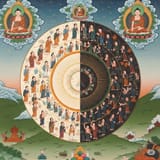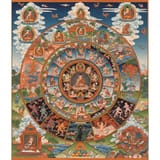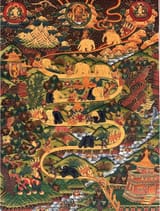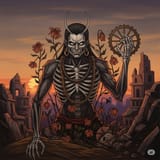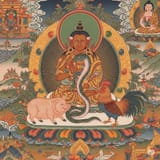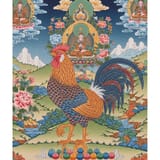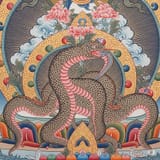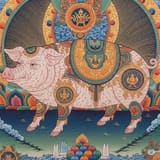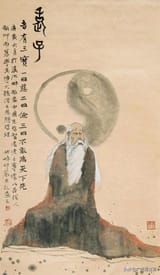Laozi
!IY3lmS5eXQ
7/19/2025, 4:01:27 AM
No.40753116
[Report]
(Lao Tzu) The Thangka Art: This image typically illustrates the "Wheel of Life"
(Bhavachakra) or a narrative of the path to enlightenment, often featuring the stages of taming the mind (represented by an elephant and monkey) or the cycle of samsara. If you'd like to know more about this, I can explain the common interpretations and elements found in such Thangkas.
Laozi
!IY3lmS5eXQ
7/19/2025, 4:01:55 AM
No.40753119
[Report]
The Bhavachakra, often called the "Wheel of Life" or "Wheel of Becoming," is a powerful and intricate symbolic representation of Buddhist teachings, especially about samsara (cyclic existence), karma (cause and effect), and the path to liberation from suffering. It's commonly found as a mural outside Tibetan Buddhist temples, acting as a visual guide for practitioners and laypeople.
Here's a breakdown of the story and symbolism within the Bhavachakra:
1. The Figure Holding the Wheel: Impermanence (Yama)
The entire wheel is held by a fierce, wrathful figure, often identified as Yama, the Lord of Death, or a demon representing impermanence. This signifies that all beings within samsara, regardless of their realm, are subject to death and the constant cycle of change. Yama's attributes (like a crown of skulls or a third eye) symbolize the impermanence of all things and the wisdom to understand it.
2. The Hub: The Three Poisons
At the very center of the wheel are three animals, chasing each other in a circle, symbolizing the Three Poisons (or Three Root Kleshas) that drive the entire cycle of suffering:
Pig: Represents ignorance (or delusion). The pig is often depicted as the root, as ignorance is seen as the fundamental cause from which other defilements arise.
Snake: Represents aversion (or hatred/anger).
Rooster/Bird: Represents attachment (or greed/desire/clinging).
These animals bite each other's tails, showing how these poisons feed into and perpetuate one another.
Laozi
!IY3lmS5eXQ
7/19/2025, 4:03:08 AM
No.40753124
[Report]
3. The Second Layer: Karma (Cause and Effect)
Surrounding the hub is a ring typically divided into two halves:
Light Half: Depicts people ascending, indicating positive actions (good karma) leading to higher, more fortunate rebirths.
Dark Half: Shows people descending, illustrating negative actions (bad karma) leading to lower, more suffering-filled rebirths.
This layer visually explains the law of karma – every action, thought, and word has consequences that determine future experiences.
4. The Six Realms of Samsara
The largest section of the wheel is divided into six segments, representing the Six Realms of Existence into which beings can be reborn, based on their karma. These can be understood as actual places of rebirth or as psychological states:
Higher Realms (Fortunate Births):
God Realm (Devas): Beings here experience immense pleasure, luxury, and long lives. However, their enjoyment can make them complacent, leading them to forget the Dharma and eventually fall back into lower realms when their good karma is exhausted.
Demigod/Jealous God Realm (Asuras): These beings are powerful and enjoy some pleasures but are plagued by jealousy, envy, and conflict, constantly striving for what the gods have.
Human Realm: This is considered the most precious realm because it offers a unique balance of pleasure and suffering. Humans have enough suffering to motivate them to seek liberation, but also enough intelligence and opportunity to practice the Dharma. It's the only realm from which one can truly achieve enlightenment.
Laozi
!IY3lmS5eXQ
7/19/2025, 4:04:12 AM
No.40753127
[Report]
Lower Realms (Unfortunate Births):
Animal Realm: Characterized by ignorance, instinctual behavior, fear, and being preyed upon.
Hungry Ghost Realm (Pretas): Beings here suffer from insatiable craving, depicted with large bellies and tiny mouths, symbolizing their inability to satisfy their endless desires (often associated with addiction and obsession).
Hell Realm (Narakas): The lowest and most suffering-filled realm, characterized by intense pain, torment, and rage, often depicted with various gruesome punishments.
Laozi
!IY3lmS5eXQ
7/19/2025, 4:05:15 AM
No.40753132
[Report]
Within each realm, a Buddha or Bodhisattva is often depicted, trying to teach the beings there, showing that even in the most difficult circumstances, the potential for liberation exists.
5. The Outer Rim: The Twelve Links of Dependent Origination (Pratītyasamutpāda)
This outermost ring illustrates the Twelve Nidanas, a chain of cause and effect that explains how beings become trapped in samsara. Each link arises from the previous one, showing the cycle of how ignorance leads to suffering and rebirth:
Ignorance (blind person)
Volitional Formations/Karma Formations (potter shaping clay)
Consciousness (monkey)
Name and Form (people in a boat)
Six Sense Bases (house with windows)
Contact (couple embracing)
Feeling/Sensation (person with an arrow in their eye)
Craving/Desire (person drinking alcohol)
Grasping/Clinging (person gathering fruit)
Becoming/Existence (pregnant woman)
Birth (woman giving birth)
Old Age and Death (corpse being carried away)
Laozi
!IY3lmS5eXQ
7/19/2025, 4:06:47 AM
No.40753141
[Report]
This cycle explains how our actions, driven by ignorance and desire, create the conditions for future births and continued suffering.
6. Outside the Wheel: Liberation
Above the wheel, there is usually an image of the Buddha pointing towards a moon or a clear, empty space.
The Moon: Symbolizes Nirvana or Liberation from the cycle of samsara. It represents a state of peace, enlightenment, and the cessation of suffering.
The Buddha Pointing: This signifies that the Buddha has shown the path to liberation, but it is up to each individual to follow that path and achieve freedom from the wheel.
Laozi
!IY3lmS5eXQ
7/19/2025, 4:08:02 AM
No.40753144
[Report]
The Bhavachakra, often called the "Wheel of Life" or "Wheel of Becoming," is a powerful and intricate symbolic representation of Buddhist teachings, especially about samsara (cyclic existence), karma (cause and effect), and the path to liberation from suffering. It's commonly found as a mural outside Tibetan Buddhist temples, acting as a visual guide for practitioners and laypeople.
Here's a breakdown of the story and symbolism within the Bhavachakra:
1. The Figure Holding the Wheel: Impermanence (Yama)
The entire wheel is held by a fierce, wrathful figure, often identified as Yama, the Lord of Death, or a demon representing impermanence. This signifies that all beings within samsara, regardless of their realm, are subject to death and the constant cycle of change. Yama's attributes (like a crown of skulls or a third eye) symbolize the impermanence of all things and the wisdom to understand it.
2. The Hub: The Three Poisons
At the very center of the wheel are three animals, chasing each other in a circle, symbolizing the Three Poisons (or Three Root Kleshas) that drive the entire cycle of suffering:
Pig: Represents ignorance (or delusion). The pig is often depicted as the root, as ignorance is seen as the fundamental cause from which other defilements arise.
Snake: Represents aversion (or hatred/anger).
Rooster/Bird: Represents attachment (or greed/desire/clinging).
These animals bite each other's tails, showing how these poisons feed into and perpetuate one another.
Laozi
!IY3lmS5eXQ
7/19/2025, 4:09:10 AM
No.40753149
[Report]
3. The Second Layer: Karma (Cause and Effect)
Surrounding the hub is a ring typically divided into two halves:
Light Half: Depicts people ascending, indicating positive actions (good karma) leading to higher, more fortunate rebirths.
Dark Half: Shows people descending, illustrating negative actions (bad karma) leading to lower, more suffering-filled rebirths.
This layer visually explains the law of karma – every action, thought, and word has consequences that determine future experiences.
4. The Six Realms of Samsara
The largest section of the wheel is divided into six segments, representing the Six Realms of Existence into which beings can be reborn, based on their karma. These can be understood as actual places of rebirth or as psychological states:
Higher Realms (Fortunate Births):
God Realm (Devas): Beings here experience immense pleasure, luxury, and long lives. However, their enjoyment can make them complacent, leading them to forget the Dharma and eventually fall back into lower realms when their good karma is exhausted.
Demigod/Jealous God Realm (Asuras): These beings are powerful and enjoy some pleasures but are plagued by jealousy, envy, and conflict, constantly striving for what the gods have.
Human Realm: This is considered the most precious realm because it offers a unique balance of pleasure and suffering. Humans have enough suffering to motivate them to seek liberation, but also enough intelligence and opportunity to practice the Dharma. It's the only realm from which one can truly achieve enlightenment.
Laozi
!IY3lmS5eXQ
7/19/2025, 4:10:41 AM
No.40753162
[Report]
Lower Realms (Unfortunate Births):
Animal Realm: Characterized by ignorance, instinctual behavior, fear, and being preyed upon.
Hungry Ghost Realm (Pretas): Beings here suffer from insatiable craving, depicted with large bellies and tiny mouths, symbolizing their inability to satisfy their endless desires (often associated with addiction and obsession).
Hell Realm (Narakas): The lowest and most suffering-filled realm, characterized by intense pain, torment, and rage, often depicted with various gruesome punishments.
Within each realm, a Buddha or Bodhisattva is often depicted, trying to teach the beings there, showing that even in the most difficult circumstances, the potential for liberation exists.
5. The Outer Rim: The Twelve Links of Dependent Origination (Pratītyasamutpāda)
This outermost ring illustrates the Twelve
Laozi
!IY3lmS5eXQ
7/19/2025, 4:11:43 AM
No.40753167
[Report]
Nidanas, a chain of cause and effect that explains how beings become trapped in samsara. Each link arises from the previous one, showing the cycle of how ignorance leads to suffering and rebirth:
Ignorance (blind person)
Volitional Formations/Karma Formations (potter shaping clay)
Consciousness (monkey)
Name and Form (people in a boat)
Six Sense Bases (house with windows)
Contact (couple embracing)
Feeling/Sensation (person with an arrow in their eye)
Craving/Desire (person drinking alcohol)
Grasping/Clinging (person gathering fruit)
Becoming/Existence (pregnant woman)
Birth (woman giving birth)
Old Age and Death (corpse being carried away)
This cycle explains how our actions, driven by ignorance and desire, create the conditions for future births and continued suffering.
6. Outside the Wheel: Liberation
Above the wheel, there is usually an image of the Buddha pointing towards a moon or a clear, empty space.
The Moon: Symbolizes Nirvana or Liberation from the cycle of samsara. It represents a state of peace, enlightenment, and the cessation of suffering.
The Buddha Pointing: This signifies that the Buddha has shown the path to liberation, but it is up to each individual to follow that path and achieve freedom from the wheel.
In essence, the Bhavachakra tells the story of:
Why we suffer: Due to the three poisons (ignorance, attachment, aversion).
How karma works: Our actions lead to specific results and rebirths.
Where we can be reborn: The six realms of existence.
The process of rebirth: The twelve links of dependent origination.
Laozi
!IY3lmS5eXQ
7/19/2025, 4:20:46 AM
No.40753217
[Report]
Anonymous
7/19/2025, 4:26:24 AM
No.40753252
[Report]
>>40753269
POO
IN
L
O
O
YHWH-Elyon El Ruach
!/T2Ij.GdEA
7/19/2025, 4:28:10 AM
No.40753269
[Report]
>>40753252
Are you happy you hacker?
YHWH-Elyon El Ruach
!/T2Ij.GdEA
7/19/2025, 4:46:28 AM
No.40753368
[Report]
Anonymous
7/19/2025, 6:51:12 AM
No.40754121
[Report]
how can this help improve my life i already live an ok life it could be better but its comfy as it
